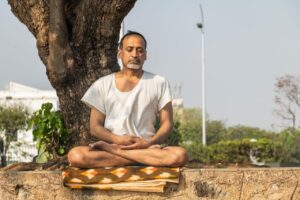Post By:
Vishwanath Iyer
Published on: November 24, 2016
Reading time: 5 minutes
How to practice meditation.
- First, sit in a secluded place. Ensure that the place is one where you can go to regularly and should have a pleasant atmosphere. Also, the temperature in the room should be conducive for long practice (sādhana).
- Next, sit on a chair or on the floor. Floor postures hold the body more firmly, this is preferred.
- Lastly, sit in a comfortable pose. Padmāsana, sukhāsana or vajrāsana are preferred, but it is possible that there is discomfort initially. If this happens, start with one of the above āsanas and re-seat to a comfortable posture for the remainder of the meditation period. Over time, one pose will become the preferred pose and the body will fall naturally into it. But the important point to remember is that the back must be erect from the coccyx upwards. The perineum, which is the seat of the mūl̄adhāra-cakra must touch the ground, forcing the spine erect.
After this,
- Next, relax the body using auto-suggestion (suggestive commands given the person to one self). Start from the top of the head and slowly relax each part. Also, try to break the command into specific locations. For example; instead of saying “relax the brain”, say “relax the front of the brain, relax the left side, relax the right side, relax the back… etc…” Consequently, this will lead to quicker and more effective relaxation. Then, relax completely. Remember that relaxation becomes deeper with practice.
- In fact, when the body has relaxed completely, it will be noticed that breathing becomes shallow and even. Observe the breathing. Importantly, watch the interval between pūraka (inhalation) and recaka (exhalation) and vice-versa. Here, there is a minuscule period of silence where the breath crosses over from inhalation to exhalation and vice-versa. Focus on this emptiness. Try to extend the silences even when breathing restarts. Also, try to keep the breathing even and without ripples or agitation.
- Stay in this position for around 10-20 minutes. Also, do not practice more the once or twice a day or for longer periods unless you are interested in deeper spiritual investigation.
What are the distractions in meditation.
The sense of identity generally keeps seeking assurance of existence, so keeps pinging the environment for assurance of existence. It latches on to any form for this assurance. This is distraction. Distraction is any activity which creates images that arise when meditating. Some are straightforward, such as watching too much TV, but there are others that are subtle and not easy to define or discriminate. This takes time and often a lot of effort. While the grosser elements may be easy to manage, the subtler elements take enormous effort. But, as a result of this effort, awareness increases.
- External distraction: This comes primarily in the form of noise and is hard to ignore. To avoid this, one could practice in the early morning hours and in a secluded part of the home. If this is not possible, then one should seek a location where this is possible. As one practices this, it becomes easier to control cognition from being hijacked!
- Internal distraction: This is harder to control. As one meditates, the Self will jump off into a thought. This thought moves to different subjects and before one knows it, one has shot off into a tangent. The harder one tries to control the mind, the more it foils attempts at control.
To control this, one must view the thought as an action that is independent of control. Allow the mind to drift but gently draw it back like a grandparent pulling back a child from danger. It is hard, but with practice, one will be able to achieve an anchor in silence and experience clarity and high level of internal awareness.
Some more tips:
- First, to avoid distraction, reduce interaction with people. Additionally, this includes social media. So, if you are active in groups, slowly reduce your activity. As a result, you will have less disturbances, because you will think less about what you wish to say.
- Second, reduce watching TV. If you are addicted to serial binging, slowly reduce the frequency and finally stop. Rightfully, the TV is called an “idiot box”, it makes an idiot out of the viewer.
- Next, reduce your exposure to news. Most of the stuff that is spoken about is sensationalised and you have no control over the outcome anyway.
- Lastly, reduce speaking. In fact, speak only when you know that you can add value or make a difference. Try to increase the silence in speech to silence within.
How can our meditation get hijacked?
This term has been used to describe what happens if the person is unable to step back from the associations that the mind continuously makes. The associations lead to emotional discomfiture, both positive and negative. Also, at extreme levels, it can completely disrupt the meditation practice.
However, these associations, images, and body responses to passions can be avoided by sustained practice of yama and niyama. Step back!
What are the measure of success in meditation.
- During practice of pratyāhāra, duality slowly gets eliminated. Darkness and light merge, silence is the preferred mode of communication and there is stillness in the self.
- There is no judgement, no fear of rejection or expectation of victory. An indifference to success, ambition, consequences, opinion, sex creeps in.
- There is no seeking, no reaching out for solution- but if a problem needs resolution, it is done with no expectation of any credit, material or otherwise.
